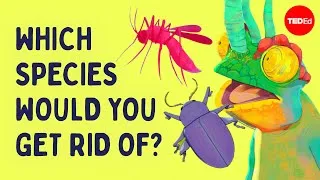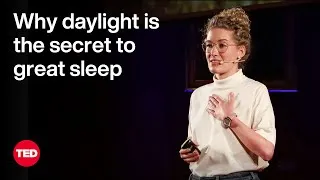請雙擊下方英文字幕播放視頻。
譯者: Anna Lee
審譯者: Zoe Walmsley
00:06
The Black Death.
0
6919
1210
黑死病、
00:08
The 1918 Flu Pandemic.
1
8379
1835
1918 年流感疫情、
00:10
COVID-19.
2
10339
1168
COVID-19。
00:11
We tend to think of these catastrophic,
world-changing pandemics
3
11883
3545
我們傾向於將這些災難性的、
改變世界的流行病
00:15
as very unlikely events.
4
15428
2294
視為不太可能發生的事件。
00:18
But between 1980 and 2020,
5
18389
2503
但從 1980 至 2020 年,
00:20
at least three diseases emerged
that caused global pandemics.
6
20892
3837
出現至少三次全球大流行的疾病:
00:24
COVID-19, yes, but also
the 2009 swine flu and HIV/AIDS.
7
24729
4921
除了 COVID-19,還有
2009 年的豬流感和愛滋病。
00:29
Disease outbreaks are surprisingly common.
8
29942
2378
疫情爆發令人驚訝地普遍。
00:32
Over the past four centuries,
9
32528
1544
過去這四個世紀中,
00:34
the longest stretch of time
without a documented outbreak
10
34072
3128
沒有發生致死率
達一萬人的疫情的時間──
00:37
that killed at least 10,000 people
was just four years.
11
37200
4296
最長不過四年。
00:42
As bad as these smaller outbreaks are,
12
42038
2169
這些小規模的疫情再怎麼糟,
00:44
they’re far less deadly than
a COVID-19-level pandemic.
13
44207
3086
殺傷力也比不上
COVID-19 等級的疫情。
00:47
In fact, many people born after
the 1918 flu lived their entire lives
14
47627
4629
事實上,許多出生於
1918 年流感之後的人,
從沒經歷過這類改變世界的疫情。
00:52
without experiencing
a similar world-changing pandemic.
15
52256
3295
00:55
What’s the probability that you do, too?
16
55843
2253
你覺得這發生在你身上的
可能性有多大?
00:58
There are several ways
to answer this question.
17
58387
2253
有幾種方法可以回答這個問題。
01:00
You could look at history.
18
60640
1668
鑒往知來。
01:02
A team of scientists and engineers
who took this approach
19
62308
2878
有個科學家和工程師團隊用這個方法,
01:05
catalogued all documented epidemics
and pandemics between 1600 and 1950.
20
65186
5422
整理出 1600 至 1950 年
所有的區域流行和跨界的傳染病,
01:10
They used that data to do two things.
21
70817
2085
用那些數據去做兩件事。
01:13
First, to graph the likelihood
that an outbreak of any size
22
73152
3587
首先是用圖表畫出在某段時間內
01:16
pops up somewhere in the world
over a set period of time.
23
76739
3128
世界各地爆發大小疫情的可能性。
01:20
And second, to estimate the likelihood
that that outbreak would get large enough
24
80409
4171
其次,估計疫情爆發的規模
01:24
to kill a certain percentage
of the world's population.
25
84580
2753
大到足以造成相當比例
世界人口死亡的可能性。
01:27
This graph shows that while huge
pandemics are unlikely,
26
87708
3629
圖表顯示,爆發大規模
疫情的可能性不高,
01:31
they're not that unlikely.
27
91587
1627
但也並非不可能。
01:34
The team used these two distributions
to estimate that the risk
28
94048
2961
該團隊使用這兩個機率分布估計出
01:37
of a COVID-19-level pandemic
is about 0.5% per year,
29
97009
4338
每年發生 COVID-19 等級的
疫情風險大約 0.5%,
01:41
and could be as high as 1.4%
30
101347
2711
但這數字也可高達 1.4%,
01:44
if new diseases emerge
more frequently in the future.
31
104058
3087
如果有愈來愈多的新型疾病出現。
01:48
And we’ll come back to those numbers,
32
108104
1793
我們會再回頭看這些數字,
01:49
but first, let’s look at another way
to estimate the likelihood
33
109897
3045
現在先看另一種
預測爆發疫情大流行的方法:
01:52
of a future pandemic:
34
112942
1293
01:54
modeling one from the ground up.
35
114235
1877
疫情的基礎理論。
01:56
For most pandemics to happen, a pathogen,
which is a microbe that can cause disease,
36
116529
4296
大多數流行病的病原體──
某種致病的微生物──
02:00
has to spill over from its normal host by
making contact with and infecting a human.
37
120825
5547
必須經過接觸才能
由原宿主轉移到人類身上。
02:06
Then, the pathogen has to spread widely,
38
126497
2753
然後,病原體必須廣泛傳播,
02:09
crossing international boundaries
and infecting lots of people.
39
129250
3629
跨越邊界去感染很多人。
02:13
Many variables determine whether a given
spillover event becomes a pandemic.
40
133713
4588
從區域流行病變成全球疫情
取決於許多變數。
02:18
For example, the type of pathogen,
how often humans come into close contact
41
138885
4296
例如,病原體的類型、
人類與原動物宿主密切接觸的頻率、
02:23
with its animal reservoir,
existing immunity, and so on.
42
143181
3461
現有的免疫力等等。
02:27
Viruses are prime candidates
to cause the next big pandemic.
43
147602
4087
病毒會是導致下一次
疫情大流行的可能主因。
02:31
Scientists estimate that there are about
1.7 million as-yet-undiscovered viruses
44
151856
5756
科學家估計約有
170 萬種病毒尚未被發現,
02:37
that currently infect mammals and birds,
45
157612
2544
主要感染哺乳動物和鳥類,
02:40
and that roughly 40% of these have the
potential to spill over and infect humans.
46
160156
4921
其中大約 40%
有可能轉移到人類身上。
02:46
A team of scientists built a model
using this information,
47
166162
2878
一班科學家使用這些資訊、
02:49
as well as data about the global
population, air travel networks,
48
169040
3461
加上全球人口、航空旅行路線、
02:52
how people move around in communities,
country preparedness levels,
49
172501
3504
區域交通方式、各國的防疫水準、
02:56
and how people might respond to pandemics.
50
176005
2419
及人們如何因應疫情等資訊
建立了一個模型。
02:58
The model generated hundreds of thousands
of virtual pandemics.
51
178799
3838
該模型模擬了數十萬次流行病疫情,
03:02
The scientists then used
this catalog to estimate
52
182720
2586
科學家們再用該數據去推算出
03:05
that the probability of another
COVID-19-level pandemic
53
185306
3170
再次發生 COVID-19
等級疫情的機率是──
03:08
is 2.5 to 3.3% per year.
54
188476
3253
每年 2.5% 至 3.3%。
03:12
To get a sense of how these risks
play out over a lifetime,
55
192563
3379
要知道一生中碰到疫情的風險有多高,
03:15
let’s pick a value roughly in the middle
of all these estimates: 2%.
56
195942
3628
我們先從這些預測數字中
取一個中間值: 2%。
03:19
Now let’s build what’s called
a probability tree diagram
57
199737
3003
再來,我們來畫一個概率樹狀圖,
03:22
to model all possible scenarios.
58
202740
2336
模擬所有可能發生的情況。
03:25
The first branch of the tree
represents the first year:
59
205243
3128
這棵樹的第一個分枝代表第一年,
03:28
there’s a 2% probability of experiencing
a COVID-19-level pandemic,
60
208371
3920
碰到 COVID-19
等級疫情的概率為 2%,
03:32
which means there’s a 98% probability
of not experiencing one.
61
212500
3920
也就是說不會碰到疫情
的概率為 98%。
03:36
Second branch, same thing,
62
216712
1710
第二個分枝,一樣的假設。
03:38
Third branch, same.
63
218589
1335
第三個分枝,也是一樣。
03:39
And so on, 72 more times.
64
219924
2544
如此類推,重複 72 次。
03:42
There is only one path that results
in a fully pandemic-free lifetime:
65
222718
4922
結果,一輩子完全不會
碰上疫情的路徑只有一條:
03:47
98%, or 0.98,
multiplied by itself 75 times,
66
227848
4880
98% 或是 0.98
自身相乘 75 次,
03:52
which comes out to roughly 22%.
67
232728
2503
結果大約是 22%。
03:55
So the likelihood of living through
at least one more COVID 19-level-pandemic
68
235856
4088
所以未來的 75 年中碰到
COVID-19 等級疫情的機率是:
03:59
in the next 75 years
is 100 minus 22%, or 78%.
69
239944
5630
100% - 22% = 78%
04:05
78%!
70
245866
1127
78%!
04:07
If we use the most optimistic
yearly estimate— 0.5%—
71
247451
4171
如果我們採用最樂觀的
每年 0.5% 的機率,
04:11
the lifetime probability drops to 31%.
72
251747
3128
有生之年再碰上
疫情的機率降到 31%。
04:15
If we use the most pessimistic one,
it jumps to 92%.
73
255042
4129
如果採用用最悲觀的 3.3%,
機率則躍升至 92%。
04:19
Even 31% is too high to ignore;
74
259839
2669
即使是 31%,也高到不容忽視,
04:22
even if we get lucky,
future generations might not.
75
262633
3212
就算我們無事,
未來幾代人未必如此幸運。
04:26
Also, pandemics are usually
random, independent events:
76
266053
3712
此外,大流行通常是
隨機的、獨立的事件,
04:29
so even if the yearly probability
of a COVID-19-level pandemic is 1%,
77
269765
4797
因此,即使發生COVID-19
等級疫情的年機率為 1%,
04:34
we could absolutely get another
one in ten years.
78
274729
2836
幾乎可以肯定十年內會再次發生。
04:38
The good news is we now have tools
that make pandemics less destructive.
79
278607
3963
好消息是我們現在擁有
降低疫情破壞力的工具。
04:43
Scientists estimated that early warning
systems, contact tracing,
80
283154
3628
科學家統計顯示出
早期預警系統、接觸者追踪、
04:46
social distancing,
and other public health measures
81
286782
2461
社交距離及其他公共衛生措施,
04:49
saved over a million lives
in just the first six months
82
289243
3253
在美國一開始遭受
COVID-19 的前六個月,
04:52
of the COVID-19 pandemic in the US,
83
292496
2419
拯救了超過 100 萬人的性命,
04:55
not to mention the millions
of lives saved by vaccines.
84
295333
3086
更別提保護了數百萬人生命的疫苗。
04:59
One day, another pandemic
will sweep the globe.
85
299587
2961
有一天,另一場疫情或將席捲全球,
05:02
But we can work to make that day
less likely to be tomorrow.
86
302840
3462
但我們可以盡量延後那一天的到來。
05:06
We can reduce the risk
of spillover events,
87
306552
2252
我們可以降低擴散的風險,
05:08
and we can contain spillovers
that do happen
88
308804
2461
針對已經擴散的,
我們也可以將之控制,
05:11
so they don’t become full-blown pandemics.
89
311265
2544
免於發展成全面性的疫情。
05:14
Imagine how the future might
look if we interacted
90
314810
2461
想像一下未來會是什麼樣子?
05:17
with the animal world more carefully,
91
317271
1919
如果人類與動物間的互動能更為謹慎、
05:19
and if we had well-funded, open-access
global disease monitoring programs,
92
319190
4337
如果有一個資金充足、
開放的全球疾病監督計劃、
05:23
AI-powered contact tracing
and isolation measures,
93
323527
2920
以人工智慧驅動的
接觸史追踪和隔離措施、
05:26
universal vaccines,
next-generation antiviral drugs,
94
326447
3295
全球普及的疫苗、
新一代的抗病毒藥物,
05:29
and other tech we haven't even thought of.
95
329742
2127
甚至其他我們尚未想到的技術?
05:32
It’s in our power to change
these probabilities.
96
332078
3003
能否扭轉這些機率取決於我們。
05:35
So, we have a choice: we could do nothing
and hope we get lucky.
97
335206
3295
我們可以選擇甚麼都不做,倚靠運氣,
05:38
Or we could take the threat
seriously enough
98
338501
2252
或者,我們可以正視威脅,
05:40
that it becomes a self-defeating prophecy.
99
340753
2419
讓它成為一個不攻自破的預言。
05:43
Which future would you rather live in?
100
343672
1961
哪一個未來是你所樂見的呢?
New videos
關於本網站
本網站將向您介紹對學習英語有用的 YouTube 視頻。 您將看到來自世界各地的一流教師教授的英語課程。 雙擊每個視頻頁面上顯示的英文字幕,從那裡播放視頻。 字幕與視頻播放同步滾動。 如果您有任何意見或要求,請使用此聯繫表與我們聯繫。







